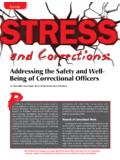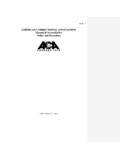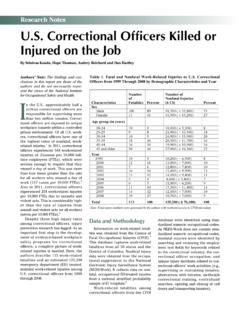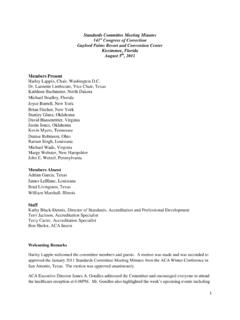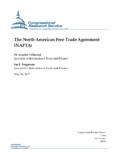Transcription of The Correctional Work Force Faces Challenges in the …
1 The work Force is becoming increasingly morediverse in terms of race and gender. In addition, avery large proportion of the work Force , specificallythe baby boomers, are approaching of these trends present significant Challenges to thenation, which, according to some experts, might lead to awork Force fact, by 2010, it is expected thatthere will be a national labor shortage of 10 million workersas the demand for employees exceeds the available appli-cant to national labor shortages, correc-tional agencies are also experiencing a labor shortage.
2 Plusproblems recruiting qualified candidates for correctionalofficer positions. Results from a 2004 study indicate that 44percent of the 44 Correctional systems and four Canadi-an systems that responded to a work Force survey face seri-ous difficulties in recruiting and retaining an adequate staffof qualified Correctional officers. The study, conducted byWorkforce Associates Inc. for the American CorrectionalAssociation, found that 82 percent of respondents (correc-tional administrators and human resource managers fromadult and juvenile institutions) reported some difficulty inrecruiting Correctional officers, with nearly one-fourth stat-ing that recruiting was extremely difficult.
3 3 Consequently, the field of corrections finds itself facingunprecedented work Force Challenges as it enters the 21stcentury. Correctional agencies are competing with othercriminal justice, governmental and private agencies forpotential applicants. Although the number of correctionalemployees expanded from 300,000 to more than 750,000(150 percent) between 1982 and 1999, the growth has notkept up with the increased demand for Correctional officers,according to the study. Current nationwide projectionsestimate that in the next decade, the will need an addi-tional 490,000 Correctional officer to fill new positionsrequired by the growth in the prison population and toreplace Correctional officers who terminate on these trends, Carroll and Moss predict that cor-rections will be second to the health care profession on thelist of fields that are most likely to be affected by an upcom-ing shortage of a result of the aforementionedfactors.
4 Recruitment and selection are among the criticalissues facing corrections, regardless of an agency s 21st Century Work ForceThe 2004 ACA-commissioned study, funded by theBureau of Justice Assistance, was initiated to help develop awork Force plan to assess the Correctional work Force Challenges across the as well as to identify promisingpractices and developing strategies that Correctional agencies can employ to strengthen their recruitmentapproaches, reduce turnover and retain qualified design encompasses three phases: Discovery Phase Develop a description of the cur-rent Correctional work Force and assess the difficultycorrectional agencies are experiencing in recruitingand retaining employees; Create Phase Identify successful recruitment andretention practices that are used by public and pri-vate organizations inside and outside of the correc-tions field.
5 And Implementation Phase Develop tools for correc-tional agencies to enhance their recruitment andretention article highlights some of the major findings fromthe discovery phase of the work Force study regardingrecruitment Challenges and a few of the key factors thathave influenced the labor Force participation of the CorrectionalWork ForceThe data from the ACA work Force study indicate that thetypical Correctional employee is a white, non-Hispanic, mod-erately educated male who is in his mid-30s. In 2001, slightlymore than three-fourths (79 percent) of Correctional officerswere male and more than half (65 percent) were white andnon-Hispanic.
6 In 1995, about 70 percent of all correc-tional officers were between 25 and 44 years old, with themajority being in their 30s. During the same time frame,nearly all Correctional officers (99 percent) were highschool graduates; slightly more than one-third (35 percent)had at least some college; about one in 10 had associatedegrees; and approximately 10 percent, of all correctionsofficers held bachelor s degrees or higher. According to thestudy, these data reveal that the profile of Correctional offi-cers who work in adult institutions share similar character-istics such as gender, ethnicity, age and education withother security and law enforcement, governmental.
7 And pri-vate occupations with which Correctional agencies competefor potential Correctional Work Force FacesChallenges in the 21st CenturyBy Melvina SumterResearch NotesHow Today s labor Market HasChanged The civilian labor Force has changed dramatically inrecent decades and is expected to change even more inyears to come. While a number of factors are responsiblefor overall changes in the labor Force participation rate, identified three significant demographic changesthat have influenced labor Force participation in most dramatic of recent demographic changesis gender, with the entry of women into the work the 1970s, the expansion of women in the labor forcehas compensated for the declining activity rate of men,increasing the overall labor Force participation rate.
8 Forexample, Toossi notes that the participation rate of womenin the labor Force was percent in 1986, percent in1996 and percent in 2006. The changing racial makeupof the population has also influenced the labor forceparticipation rate. Whereas white non-Hispanics accountedfor nearly 80 percent of the labor Force in 1986 and 75 per-cent in 1996, their share is expected to fall to nearly 65 per-cent of the labor Force by 2016, according to Toossi. Recent work Force projections released by the of labor indicate that only 15 percent of thenew entrants into the work Force will be white, non-Hispan-ic males; the other 85 percent will be women, ethnicminorities and trends are alsoobserved in the Correctional work Force , where the numberof white, non-Hispanic males decreased from 72 percent in1992 to 65 percent in 2001, a decline that is expected tocontinue in the Correctional work Force .
9 A third trend is theaging of the labor Force , driven largely by baby boomerswho are expected to retire in the near future. Moreover,between 2000 and 2010, the Census Bureau projectsthat the number of Americans age 25 to 44 will decrease bymore than 4 ACA study states that the genera-tion that follows the baby boomers is numerically muchsmaller and is expected to change the work culture signifi-cantly. These newcomers to the work Force change jobsoften and are not likely to spend their full career in oneagency, or even in one occupation.
10 They also do notembrace the dress code or management styles accepted bythe baby boomers, and unlike their parents, they do notexpect work to be or consume their and Selection ChallengesStudy respondents noted that inadequate pay and bene-fits, burdensome hours and shift work, a shortage of quali-fied applicants, and undesirable location of correctionalfacilities are factors that render recruiting difficult. Theyalso stated that that their agencies are competing withother criminal justice agencies, specifically law enforce-ment, the federal government and private sector agencies,that offer more attractive jobs, pay and benefit packagesfor well-qualified potential Correctional applicants.

